The various domestic traffic regulations are almost unanimous in requiring that the shipper of a package mark this package in such a way that the marking is permanent, clearly visible and cannot be confused. The markings must correspond to the specifications in the consignment note. All old addresses and labels must be removed or clearly negated. In some areas, it is also necessary to specify both the shipper and the recipient.
Part 1 of the current DIN standard 55 402 entitled "Shipping marks for packages" describes the pictorial markings for the handling of goods, and Part 2 provides a directive for export packaging. Adherence to such standards should ensure uniform marking of the packages to be shipped. The standard does not apply to advertising and required information that is regulated by the guidelines of various transport service providers, such as the postal services, the rail services or by individual countries. Further information can be found in ISO/DIN 780.
Markings should always be restricted to the necessary information. They should be applied without a border, and must be easily legible and permanent. They must be able to withstand the rigors of transportation.
Black should be used if possible. It must, however be ensured that the markings contrast with the color of the package. Where adhesive labels are used, the standard recommends black printed on a white background. The colors not permitted by the DIN standard are those that are reserved for hazardous goods, for example, orange and bright red.
The hazardous goods regulations previously demanded that a border was placed round the symbol. This is no longer the case.
If goods are relabeled, both the pictorial marks and the lettering of the old markings should be made illegible. This is intended to eliminate all risk of errors and misdirection.
The specifications in the shipping documents must match the specifications on the packages themselves. The problem for the practitioner here is that even if an incorrect or incomplete marking is applied, they are not permitted to correct the markings or add markings without authorization. Otherwise this could lead to problems with customs, foreign trade banks and similar interested parties.
Those who are responsible for the packing and labeling of goods must be familiar with the various standards, or have them available for reference, and must act in accordance with them.
For those who "only" deal with the transportation of the packages, it is important that they are able to read and interpret the markings on the packages and not that they should be able to attach or modify these markings.
Labeling in accordance with the standards
According the various standards, the labeling is to be made up of the following items of information. The sequence should be adhered to unless special directives apply for particular circumstances.
Example of a marking that conforms to the standards:

The shipping mark and the statement of origin should be arranged one below the other. The weight and the dimensions should be applied to the bottom right of the package, and handling information preferably to the top left.
For cuboid packages, the handling information and the markings should not be separated. They should be applied to at least two adjoining sides. The only exceptions to this rule are pictorial markings that are tied to a specific location, for example, those showing the center of gravity. For cylindrical objects, it is sensible to apply the labeling to two opposite sides. It is sufficient to mark bagged cargo and bales on one side only.
 |
Marking on a bale of tobacco from Indonesia |
| Incorrect marking: Handling information and marking are separated |
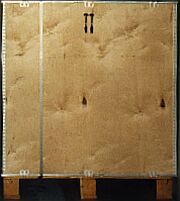 |
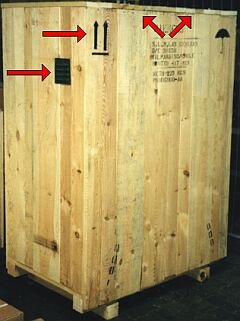 |
Incorrect marking and design |
The pair of arrows should have been on the front of the crate. All marking should also have been duplicated on an adjacent side. A comment on the case: It is constructed in such a way that the lid boards can lift easily if slinging equipment with multiple cables and a single hoisting point is used. Here, either metal corners should be used or the lid boards should be recessed or rabbeted. The air vent protrudes by approximately 1.5 cm. This may be torn off or may damage other goods during packing.
Information that is not required for shipping should not detract from the effectiveness of the markings. They should thus not be applied to the same sides as the markings.
Unless otherwise specified in other regulations, all markings are to be effected using Arabic numerals and in capital letters. The size of the letters will depend on the amount of space available and is specified in the standards. Clarity and legibility must be ensured. The letters and numbers of the shipping mark should contrast with other markings. All letters and numbers should, however, be smaller than the specified handling instructions.
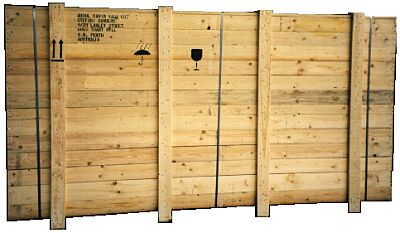 |
||
| Markings that do not comply with the standards | ||
Here, neither the size nor the location of the labeling meet the requirements of the standards.
Unfortunately the existing regulations are rarely applied in practice. In the event of doubt about the meaning of a marking, information should be obtained as soon as possible from experts or from the persons/institutes responsible. This is particularly important for hazardous goods markings as well as the sling here and center of gravity markings.
Shipping mark
The shipping mark of a package includes the identification mark, the identification number, the address and the total number of packages in the consignment, as well as the sequential number of the package within the consignment.
Identification mark
The identification mark may be the first few letters of the name of the shipper or recipient or the company name of the recipient.
Identification number
The identification number may be, for example, the order number, consignment note number or bill of lading number among other things.
Address
If the package is to be received at a port, the name of the port only should be specified. If the package is to be transported further once it has reached port, then the address should be specified as the destination via the destination port.
Total number of packages in the consignment, sequential number
The total number of items in the consignment must be specified plus the sequential number of the package within the consignment.
Information markings
Information markings include information about the country of origin, and the weight and dimensions of the package.
Statement of origin
The statement of the origin must be in accordance with the requirements of the relevant countries. The statement of the country of origin is often mandatory. In some cases, however, it is not desired.
Weight
As of a gross weight of 1,000 kg, packages must display weight information. With regard to ease of transport, handling and storage, however, the relevant standards also recommend indicating the weight in lighter packages.
Dimensions
The standards state that the dimensions of a package should be specified in centimeters.
Handling symbols
In order to guarantee the correct handling of packages and goods, pictorial symbols are used. The use of textual information to enhance the pictorial symbols should be avoided.
The pictorial symbols are to be applied without a border. In the past, the hazardous goods regulations required the use of pictorial symbols with a border to identify hazardous goods. This is no longer the case. The authorities will generally tolerate a border if there is one.
Meanings of the pictorial symbols according to DIN, ISO and IEC
The German meanings of the pictorial symbols in accordance with the German standards and the English meanings as defined by the International Organization for Standardization and IEC are described in the following section.
| Symbol | Meaning according to DIN | Meaning according to ISO |
 |
Keep dry | Keep dry |
Since goods of this type should also be protected from high levels of humidity, they must be transported in closed vehicles or containers. If it is only possible to transport particularly heavy or bulky goods on platforms, flats or in open top containers these must be covered carefully using tarpaulins.
 |
||
| Tarpaulin-covered case with the umbrella symbol | ||
Load securing issues will not be discussed here (although the securing could be improved). The important consideration is that the cover must be water-tight and that it is not possible for condensation to form below the tarpaulin. This can only be achieved with considerable effort. More information and hints about using tarpaulins can be found elsewhere. The cover must be as securely lashed as possible to make sure that it cannot be detached or destroyed by stormy conditions.
| Symbol | Meaning according to DIN | Meaning according to ISO |
| Protect from heat - But also: Protect from sunlight |
Keep away from heat |
In order to comply with the requirements of this symbol, goods traveling to certain climatic regions can be loaded into insulated containers or vehicles, or at the very least, an appropriate distance to the vehicle or container walls and roof should be maintained. Remember: Any gaps must be filled in.
When goods are imported from abroad, symbols are often used which are not ISO-compliant. In the vast majority of instances, these symbols can be understood by the storage and handling staff and leave little room for misinterpretation.
 |
The Chinese symbol for "Keep away from heat" |
Here, the sun as a source of heat is easy to recognize. Identifying the second symbol as a source of heat is somewhat more difficult.
| Symbol | Meaning according to DIN | Meaning according to ISO |
| Use no hooks | Use no hooks |
Any other kind of point load should also be avoided with goods marked with this symbol. However, this symbol does not ban the so-called plate hooks that are sometimes used to manually move appropriately marked, robust, bags made of natural materials such as sisal, hemp, jute etc.
| Symbol | Meaning according to DIN | Meaning according to ISO |
 |
DIN does not recognize this symbol | ISO does not recognize this symbol |
| Internationally understood meaning | ||
| Plate hooks may be used | ||
| Symbol | Meaning according to DIN | Meaning according to ISO |
 |
Center of gravity | Center of gravity |
This symbol is intended to provide a clear indication of the position of the center of gravity. It only makes sense to use this symbol if the center of gravity is not in the middle of the object. If there are no symbols giving the location of the center of gravity, the warehouse and handling staff can safely assume that the center of gravity is in the middle of the load.
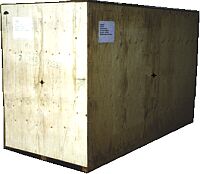 |
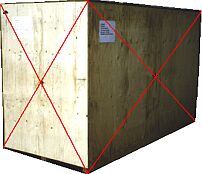 |
|
| Unnecessary center of gravity marking | ||
If a load with a center of gravity which is not the middle of the object is not marked up accordingly, the shipper/packer of the load can be held responsible in the event of accidents or damage.
The center of gravity is clearly identified if the symbol is applied to two adjacent sides (at right-angles). The DIN standard, however, recommends that it be applied to three surfaces, namely two adjacent sides and the top. This is particularly relevant for large and heavy packages as the operator of the lifting equipment is then also able to see that the center of gravity is not in the middle of the package.
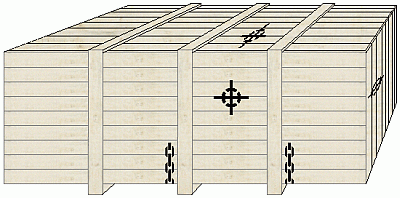 |
||
| Marking the center of gravity on three sides of a load, in accordance with the DIN standard | ||
Exports destined for countries of the former Soviet Union should use the Russian symbol for the center of gravity. There, the cross is placed below the circle.
 |
Russian symbol showing the center of gravity |
Containers with a center of gravity that is outside the specified tolerance of ± 2' (≈ 60 cm) for 20' containers and ± 3' (≈ 90 cm) for 40' containers must always be marked with the center of gravity symbol. Permits must also be obtained from the transportation and handling companies with regard to the special location of center of gravity.
For some decades now, the DIN standard has not included the "top-heavy" symbol. This was symbolized by a weight balanced on an inverted triangle. It formerly had to be used for objects with a center of gravity above the middle of the object. As can be seen from this picture (taken recently) the information that this symbol should no longer be used has not yet reached all shippers.
 |
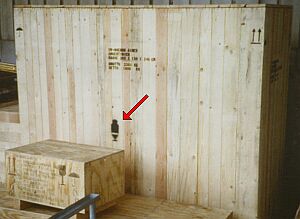 |
|
| Package showing the outdated "top-heavy" symbol | ||
| Symbol | Meaning according to DIN | Meaning according to ISO |
| Clamp here | Clamp here |
The statement that the package may be clamped at the indicated points is logically equivalent to prohibiting clamping anywhere else.
| Symbol | Modified symbol as used in practice |
 |
Only clamp with the specified pressure |
This is a very useful piece of information in practice. The example gives the specified maximum pressure as 0.77 kPa (kilopascal) or 7.7 hPa (hectopascal) or 0.00077 MPa (megapascal). Expressed in the unofficial, yet still widely used units of pressure, this is 0.0077 Bar or 0.077 kg/cm² or kp/cm². For handling staff, the specification 0.077 t/m² may also be helpful.
| Symbol | Meaning according to DIN | Meaning according to ISO |
| Sling here | Sling here |
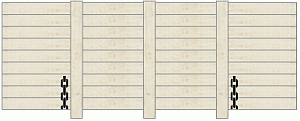 |
||
| Case with a center of gravity in the middle of the load | ||
 |
||
| Case where the center of gravity is not central | ||
If the "sling here" symbols for a load with a central center of gravity are equidistant from the middle or are equidistant from the center of gravity for an off-center load, then the package will be level when suspended if slinging equipment of the same length is used.
 |
||
| Case whose center of gravity is not central and with asymmetric slinging instructions |
||
If this is not the case, the slinging equipment must be shortened appropriately where the distance to the center of gravity is shorter. If one were to attempt to use slinging equipment of the same length the case would not be level. Thus, in the example above, the case would tilt considerably to the left and may fall.
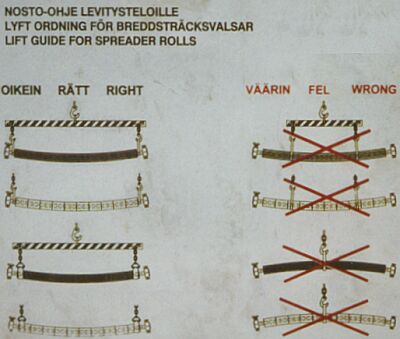 |
||
| Additional slinging information using special markings | ||
With certain goods that must be slung in a particular way, it makes sense to provide warehouse and handling staff with additional information to help them handle the object properly. The example shown here is easily understood.
Continued in Section 4.1.4.2